Acer Aspire S7 Ultrabook: Acer’s Best Foot Forward
by Jarred Walton on January 7, 2013 4:30 AM EST- Posted in
- Laptops
- Acer
- Intel
- Ivy Bridge
- Aspire S7
- Ultraportable
- Ultrabook
Performance, Now with Windows 8
As this is the first laptop we're testing with Windows 8, we've had to go back and revamp our testing suite a little bit. For example, PCMark Vantage simply refuses to complete under Windows 8 on the S7, and the same goes for a few other old Futuremark programs; we'll add the next versions of PCMark and 3DMark when they become available, but PCMark 7 and 3DMark 06 and 11 are the only Futuremark tests we’ll be running for now.
We're also taking the opportunity to upgrade several of our older benchmarks; we've been using the x264 HD 2.x encoding benchmark for a while now, but we're going to upgrade to 5.x with Windows 8—which, incidentally, takes about 10x as long to run. We will also be adding WinZip as a benchmark, with OpenCL acceleration enabled. Another benchmark we're adding with the S7 is TouchXPRT (currently in preview release) and a similar test from the same company called WebXPRT 2013. Anand has used both on the Clover Trail/Surface reviews, so it will be interesting to see what Ivy Bridge looks like by comparison. I’m not going to spend a lot of time on the tablet comparisons in terms of performance, but I also ran most of the current suite of tablet benchmarks, which we’ll look at on the next page (SunSpider, Kraken, etc.)
For the time being, that should be sufficient, but we'll be certain to add other benchmarks and tests to the mix as we deem them appropriate, so if you have any recommendations or suggestions we're happy to hear them. We will begin as usual with PCMark 7, which gives us at least some inkling of overall performance, along with our usual suite of CPU-centric tests. We shouldn't see any major surprises here, as the Acer S7 has the same components as many other Ultrabooks that we've tested. Here’s the quick overview of the test components for the various laptops:
| Laptop Configuration Overview | ||||
| Laptop | CPU | Graphics | Storage | Battery |
| Acer Aspire S3-951-6432 | Intel i7-2637M | HD3000 | 256GB SSD | 38Wh |
| Acer Aspire S5-391-9860 | Intel i7-3517U | HD4000 | 2x128GB SSD | 35Wh |
| Acer Aspire S7-391-9886 | Intel i7-3517U | HD4000 | 2x128GB SSD | 35Wh |
| Apple MacBook Air 13 (Mid-2012) | Intel i5-3427U | HD4000 | 256GB SSD | 50Wh |
| ASUS Zenbook Prime UX31A-DB71 | Intel i7-3517U | HD4000 | 256GB SSD | 50Wh |
| Dell XPS 13 | Intel i7-2637M | HD3000 | 256GB SSD | 47Wh |
| HP Envy 14 Spectre | Intel i7-3667U | HD4000 | 2x128GB SSDs | 56Wh |
| HP Folio 13 | Intel i5-2467M | HD3000 | 128GB SSD | 60Wh |
| Intel IVB Ultrabook Prototype | Intel i5-3427U | HD4000 | 240GB SSD | 47Wh |
| Toshiba Satellite U845-S406 | Intel i5-3317U | HD4000 | 500+32GB Hybrid | 54Wh |
| Toshiba Satellite U845W-S410 | Intel i5-3317U | HD4000 | 500+32GB Hybrid | 54Wh |
Before we get to the actual tests, I want to make note of the fact that this is bar none the fastest booting laptop or PC that I've ever used! Just how fast does the laptop boot up? How about under 10 seconds? Granted, much of that is probably Windows 8 (Dell’s XPS 12 posts similar boot times), but it's still impressive nonetheless. Shutdown, hibernate, and resume are all equally fast, though if all you do is put the laptop to sleep and wake it up you won’t need to worry too much about such things.
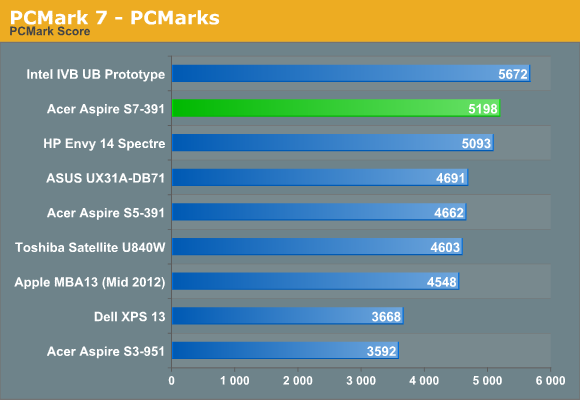
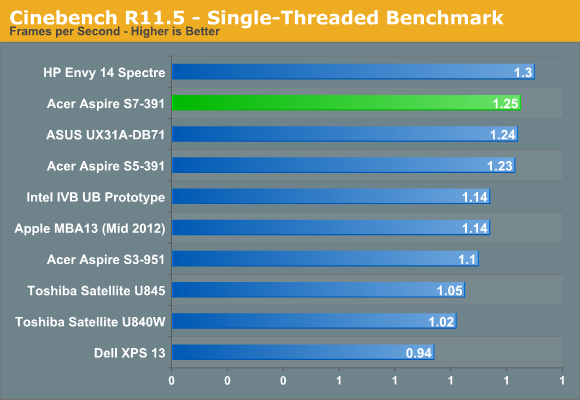
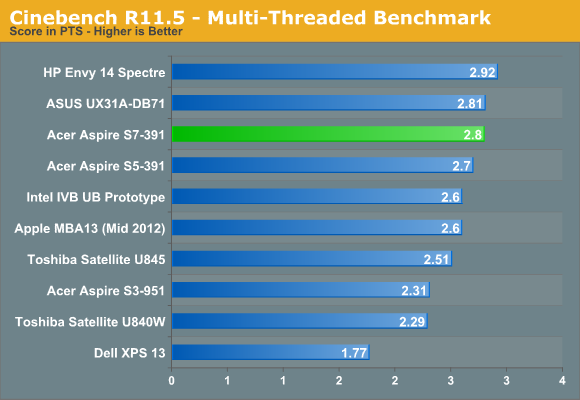
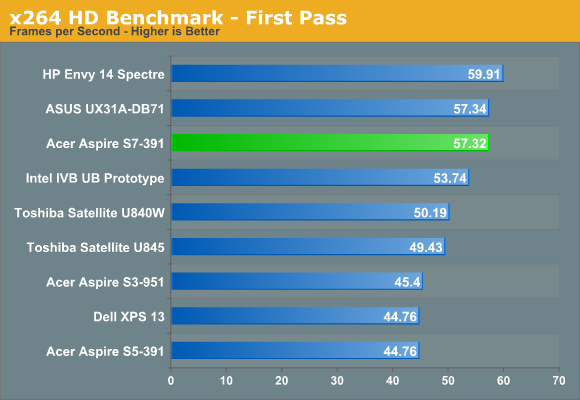


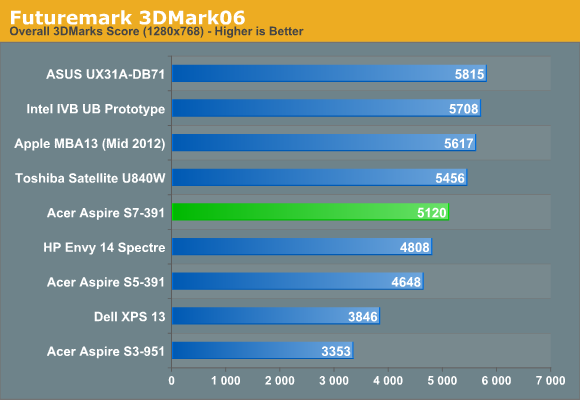
Our benchmarks start with an interesting piece of information: the Ivy Bridge prototype that Intel sent us still manages to hold onto the top spot in the overall PCMark 7 score, thanks in particular to its performance in the Creativity, Entertainment, and Computation suites—and this despite the fact that it’s equipped with a Core i5-3427U compared to the i7-3517U in other systems. (We only show the overall score above, but you can see the full set of PCMark7 results in Mobile Bench.)
It’s not quite clear what’s holding the S7 back, but while it has the top Storage score, it falls well short in the Lightweight and Productivity suites. Possibly Windows 8 is partly to blame, or more likely the combination of components (and possibly that RAID 0 storage setup) are coming into play. Then again, PCMark7 is prone to odd variations, and depending on the drivers (Quick Sync) and storage you can see large differences between what should otherwise be similar laptops—just look at how the earlier Aspire S5 with Windows 7 stacks up to the new Aspire S7!
The other benchmark charts are more in line with what we’d expect. HP’s Envy 14 Spectre snags the top spot for all of the CPU benchmarks, which makes sense considering it has the highest clocked i7-3667U processor of the bunch. The Acer S7 and ASUS UX31A are tied, which goes with their identical CPUs. 3DMark06 does show the Acer falling behind, but here again I’d look more at Windows 8 than anything specific to the S7. The march of time and/or drivers also shows a nice progression when looking at the S3, S5, and S7










53 Comments
View All Comments
blue_urban_sky - Tuesday, January 8, 2013 - link
Why stop there, make it an even 1" then you could have 2 memory slots and a removable hard drive. Or even better make it 1.5" and have a huge removable battery, an optical drive and a dedicated GPU! No make it 2" and 17" screen then you can have a full sized keyboard top of the range graphics high end CPU tons of storage and neon lights on the top of the shiny plastic case!!1!Not really aimed at you, just all the people who like there £300 lappy and can not possibly imagine a world where other people want different things.
thesavvymage - Tuesday, January 8, 2013 - link
you totally did not comprehend what i meantblue_urban_sky - Wednesday, January 9, 2013 - link
You can't see the point of making the thinest laptop.You think they should have made it fatter and increased the stats.
You justify this by saying people could not tell the difference without a ruler.
You fail to understand that increasing the height from 0.5"->0.7" is a 40% increase in volume where "overall volume are what matters the most" .
rarson - Thursday, January 10, 2013 - link
You completely failed to grasp his point. Making the thinnest laptop possible doesn't make any sense if it adds too much to the price. If it compromises too many variables, then it's obviously more logical to make a slightly thicker device. All you're doing is reconstructing his statements into a straw man. You're also using percentages to make your argument sound stronger, but nobody cares about percentages. We're talking about actual thickness here. You know, real world stuff. Nice try.blue_urban_sky - Friday, January 11, 2013 - link
Joy the straw man miss used again. They were to illustrate that I understood their position thus arguing against "you totally did not comprehend what i meant".Shall we dissect your truism :-
"Making the thinnest laptop possible doesn't make any sense if it adds too much to the price"
Is that too much according to you or is it a standardised figure? So your argument can be read as
"Making the thinnest laptop possible makes sense if it doesn't add too much to the price"
And:-
"If it compromises too many variables, then it's obviously more logical to make a slightly thicker device."
Compromises on variables that you hold above others. So this could be rearranged to
"If it doesn't compromise too many variables, then it's obviously more logical to make a thinner device."
Lastly
"but nobody cares about percentages. We're talking about actual thickness here. You know, real world stuff."
I commend that you went to the trouble of asking everyone (out of interest did you insult them as well?). Ahh I didn't realise we were talking about 'actual' thickness!
You're also using 'actual' to make your argument sound stronger (sry couldn't resist).
The real world works by iterative development things happen in small increments.
rarson - Thursday, January 10, 2013 - link
I'd even argue ergonomics are now more important than overall bulk. Modern laptops just aren't that thick or heavy anymore, so I don't understand why some people are claiming that a pound here or a half-inch there are worth the ridiculous price premium. I also don't understand what a touchscreen has to do with being light and thin, but I digress.I realized how much I appreciate the 15" size when I tried using an 11" netbook for an extended period of time. The keyboard was just far too cramped. 10 inches might be a good size for a tablet, but when I want keys, I'd rather give up some size and thickness for better keys and room for my hands to be comfortable. Having the extra screen space of a slightly larger chassis is a bonus, and coming from an 11" chassis, there's no comparison.
I've got an old PII laptop that until recently I would occasionally use. That thing probably weighs about 9 or 10 pounds. It's nicely built, and even has a matte screen, but it does get heavy to hold. I can't help but think that the 5-and-a-half pound notebook I'm using right now is pretty darn light. It's lighter than the 6-lb bowling ball I used to throw when I was 8. It's also got a bigger screen and a much nicer keyboard than this Acer, and cost about a fourth of the price.
Clearly, these ultrabooks are toys for suckers who think their social status depends on what kind of gadgets they own.
Tech-Curious - Thursday, January 10, 2013 - link
Agreed. Well said.blue_urban_sky - Friday, January 11, 2013 - link
*sigh* You were doing well right up to your last paragraph.B-
dszc - Wednesday, January 9, 2013 - link
Jarred,Thanks for your review. And special extra thanks for emphasizing productivity features and ergonomics for people who actually work.
I am a professional photographer and full-time businessman. I live in Photoshop, Excel, Word, eMail, and web research. That is what I must do and what I enjoy doing. I never play games.
Your comments on the action and utility of the keyboard and its layout are crucial. Also the touchpad. The keyboard and its shortcuts, along with the touchpad is where most true workers live. We can get things done 10x faster with these interfaces than with a touchscreen.
Thank you for continuing to harp on these issues, as they are critical. Yes, a pretty face is nice to look at, but the real beauty of a computer is in its function.
As for price, I am by no means rich, but I am more than willing to pay for an excellent productivity tool. If a laptop must cost $1100 or 1200 or 1300 to have essential features such as a decent IPS panel and a decent backlit keyboard and a decent touchpad, then so be it. But if you take away the backlit keyboard to save $20 or $50 or whatever, then the laptop to me becomes useless.
There are tons of functionally compromised laptops for the masses that are hobbled by pricepoint. But it is not right to reduce those of us who must work for a living to the lowest common denominator.
Kudos to Acer for stepping up with an IPS screen. I would be MORE than willing to pay $1300 for this tool if Acer had bothered to get the little things right - excellent backlit keyboard with great layout; fantastic (rather than mediocre) touchpad; decently calibrated IPS panel. And I'd much rather pay $1400-$1500 to have these things RIGHT, than $1200-$1300 and have them not quite right.
Thanks again, Jarred, for your great reviews.
Thanks, Acer, for moving in the right direction. Please don't stop short of the goal.
bobjones32 - Thursday, January 10, 2013 - link
I'm a huge tech dork as you'd expect considering I'm reading AnandTech. So when my wife decided to get this laptop, I gave her a quick Windows 8 tutorial as if I was teaching an alternate version of myself how to use it."Just click the desktop"
"Just use the trackpad, why use touch?"
"You can mostly ignore the Metro stuff, that's just meant for tablets"
Cut to my surprise when she basically ignores all that advice, and absolutely falls in love with the laptop using touch almost all the time, sticking in Metro apps almost all the time, and barely ever seeing the Desktop.
When the laptop is sitting on a desk, she's always resting on her elbows anyway, so reaching toward the screen is natural. When the laptop is sitting on her lap, her thumbs are right there at the screen, so it's perfectly natural to reach out and touch it. Metro apps meet most of her needs for web browsing, playing games, and chatting with friends, so she really only uses the Desktop for Office.
The keyboard is a bit annoying to her, but everything else about the laptop is nearly perfect. Even the battery life, considering that she's coming from a Vista-era laptop from 5-6 years ago that was upgraded to Windows 7.
After observing her learn to use Windows 8 and eventually fall in love with it and this laptop, it really made me rethink my expectations for the OS in general. Maybe the tech press has it wrong because they're approaching it from expectations that normal people simply don't care about?